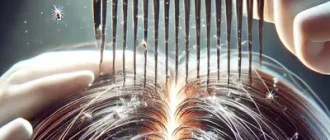What is hair loss, and when should you worry? Hair loss, also known as alopecia, occurs when the natural balance between hair shedding and growth is disrupted. While it’s normal to lose about 50-100 strands of hair daily, noticing significant clumps in your brush or shower drain could be a red flag. But how do you differentiate between normal hair shedding and a potential hair loss problem?
Hair Loss by Age Group
What are the common signs of hair loss?
Here are some telltale signs:
- Excessive Shedding: If you frequently see hair on your pillow, in your sink, or scattered on your floor, it’s time to take note. Pay attention to how much hair is left behind after brushing or washing. A consistent pattern of shedding in large quantities, particularly during specific activities, may indicate an underlying issue.
- Thinning Hair: A noticeable reduction in hair volume, especially at the crown or part line, is a classic symptom. You might find it harder to style your hair or notice it takes less time to dry, which can be subtle clues to thinning.
- Bald Patches: Circular bald spots could indicate conditions like alopecia areata. These spots can appear suddenly and might feel smooth to the touch. Sometimes, there is itching or discomfort in the affected area before hair loss occurs.
- Receding Hairline: Common among men, this can also affect women and often starts at the temples. A receding hairline can progress slowly or rapidly, and documenting its changes with photos can help identify its pace.
- Widening Part: Women might notice their part becoming more visible over time. This widening can spread gradually and may become more evident under bright lighting or with certain hairstyles, like ponytails or buns.
What causes hair loss?
Understanding the root cause is crucial for addressing hair loss effectively. Here are some major culprits:
- Genetics: Hereditary hair loss (androgenetic alopecia) is the most common form and affects both men and women.
- Hormonal Changes: Pregnancy, menopause, or thyroid imbalances can disrupt the hair growth cycle.
- Stress: Physical or emotional stress can trigger temporary hair loss, known as telogen effluvium.
- Medical Conditions: Autoimmune diseases, scalp infections, and nutritional deficiencies are notable contributors.
- Hairstyling Practices: Frequent use of heat tools, tight hairstyles, or harsh chemicals can lead to traction alopecia.
Causes of Hair Loss
Did you know?
Hair grows about 0.5 inches per month on average, amounting to roughly 6 inches per year. Your diet, age, and overall health significantly influence this growth rate.
How can you assess your hair health at home?
The Pull Test:
Gently pull a small section of clean, dry hair. If more than 10% of the strands come out, it might indicate an issue.
Scalp Examination:
Use a mirror or ask someone to check your scalp for redness, scaling, or bald patches. These could signal underlying conditions like psoriasis or fungal infections.
Hair Density Check:
Compare old photos to recent ones to assess changes in hair density. This visual comparison can provide clear evidence of hair thinning.
When should you see a specialist?
If you notice persistent hair loss that worsens over time, consult a dermatologist or trichologist. These professionals can perform diagnostic tests like a scalp biopsy or bloodwork to pinpoint the cause and recommend targeted treatments.
Treatment Options for Hair Loss
Over-the-Counter Solutions:
- Minoxidil (Rogaine): FDA-approved for stimulating hair regrowth.
- DHT Blockers: Shampoos containing ketoconazole or saw palmetto may help reduce hair loss.
Prescription Medications:
- Finasteride (Propecia): Commonly prescribed for men with androgenetic alopecia.
- Spironolactone: Sometimes used off-label for women with hormonal hair loss.
Advanced Therapies:
- PRP (Platelet-Rich Plasma): Involves injecting your own platelet-rich blood into the scalp to encourage growth.
- Hair Transplant Surgery: A permanent solution for severe cases.
Effectiveness of Treatments
| Treatment | Effectiveness (%) |
|---|---|
| Minoxidil | 70% |
| Finasteride | 85% |
| PRP Therapy | 60% |
| Hair Transplant | 90% |
| DHT Blockers | 50% |
Can lifestyle changes help?
Absolutely! Here are some steps you can take:
- Balanced Diet: Ensure adequate protein, iron, and vitamins like Biotin and Vitamin D. Include nutrient-rich foods like eggs, fish, spinach, and nuts, which promote healthy hair growth. Supplements can help, but aim to get most nutrients from natural sources for optimal results.
- Stress Management: Practice mindfulness, exercise regularly, and prioritize sleep. Activities like walking in nature or even journaling can significantly lower stress hormones that contribute to hair loss. A consistent bedtime routine can also enhance hair recovery.
- Gentle Hair Care: Use sulfate-free shampoos, avoid excessive heat styling, and opt for loose hairstyles. Experiment with hydrating conditioners or hair masks to strengthen and protect your strands, especially if you frequently color or treat your hair.
Diet and Hair Health
| Nutrient | Contribution to Hair Health (%) |
|---|---|
| Protein | 90% |
| Iron | 75% |
| Biotin | 80% |
| Vitamin D | 70% |
| Omega-3 Fatty Acids | 65% |
A closer look at the statistics
According to the American Academy of Dermatology, nearly 80 million Americans (both men and women) experience hereditary hair loss, making it one of the most common dermatological issues today. This condition doesn’t just affect the scalp; it can have significant emotional and social implications as well.
Additionally, stress-related hair loss surged by 30% during the pandemic, reflecting the growing connection between mental health and physical well-being. Prolonged stress disrupts the hair growth cycle, often leading to thinning or shedding that can persist for months after the stressful event.
These statistics underscore the importance of addressing both the physical and psychological contributors to hair health.
Editorial Advice
If you’re concerned about hair loss, don’t ignore the signs. Early intervention can make a significant difference. Begin with simple at-home assessments and consider professional guidance to uncover the root cause and explore tailored treatment options. Remember, healthy hair often reflects a healthy body, so a holistic approach is key.
About the Author
Reyus Mammadli is the author of this health blog since 2008. With a background in medical and biotechnical devices, he has over 15 years of experience working with medical literature and expert guidelines from WHO, CDC, Mayo Clinic, and others. His goal is to present clear, accurate health information for everyday readers — not as a substitute for medical advice.







